
Tel:
024 7651 1228
History of Willenhall
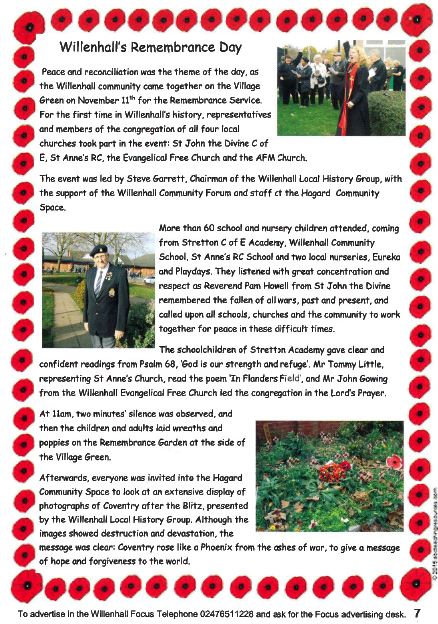
Willenhall between the years 2010 - 2019
- 2011: St George’s Day celebration at the Hagard, 23rd April
- June 6th: death of History Chairman John Russell after a short illness
- 2013: In July, the Willenhall Neighbourhood Plan application was submitted
- In November 2013 WREN awarded the Hagard £65,000 for refurbishment
- 2014: The Trussell Trust Food Bank distributed emergency supplies from St John the Divine Church
- 2015: VJ Day was commemorated on 14th August with a service on the Village Green
- On November 11th, Rev Pam Howell led her first Remembrance Service in Willenhall
- September 2016: Willenhall Library moved into the Hagard
- 2019: The life of Betty Ennis
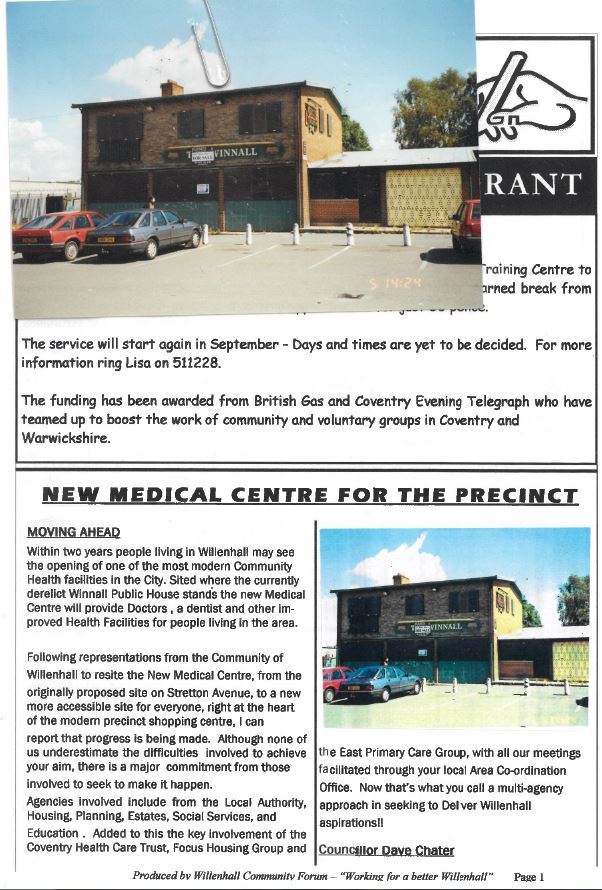
Willenhall between the years 2000 - 2009
- 2001: Willenhall Local History Group met for the first time in September
- 2002: Work began on a new health centre for Willenhall, on the site of the Winnall public house
- 2003: The Willenhall and Proud Festival took place from 21st to 26th July, to celebrate the 50th anniversary of the building of the new Willenhall Estate
- 2004: Willenhall Wood and Chace Primary School amalgamated to form Willenhall Community Primary School The Willenhall Festival took place in July
- 2004: On 21st December, Rev Katrina Scott led a memorial service for the plane crash victims and a plaque was installed next to the site of the crash
- 2005: Dr Muriel Bagley died (1934-2005)
- 2005: The Village Green, which transformed a piece of wasteland at the side of the Hagard into a pleasant amenity, was declared open during a St George’s Day celebration on April 23rd
- 2005: WCF won an achievment award from Whitefriars Housing for its work developing the Village Green
- 2006: Social Club
- 2007: St John the Divine Church celebrated its 50th birthday The Willenhall Club was also 50 The WEET Centre celebrated its 10th birthday The Willenhall Carnival was held on July 21st
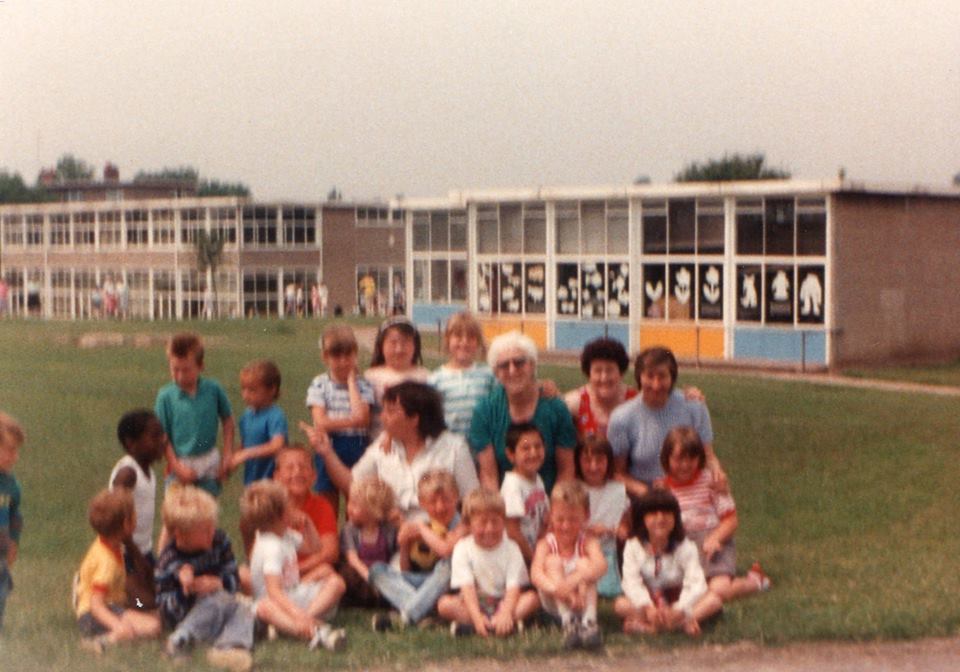
Willenhall between the years 1990 - 1999
- 1990: Willenhall Social Club in Robin Hood Road was refurbished
- 1991: West Midlands Police Authority granted permission to purchase land on Chace Ave to build a new Police Station
- 1992: Willenhall Flexible Learning Centre in the Hagard Community Centre held classes to help Asians learn English
- 1992: Britain's first Money Help Centre opened in Remembrance Road
- 1992: Chace Primary School closed
- 1993: Willenhall Church of England Primary School wasrenamed St John the Divine C of E Primary School
- 1993: Eric Hagard, after whom the centre on Remembrance Road was named, died aged 77
- 1993: The Hagard Community Centre, Willenhall was redesigned, with areas for small children and sports for elderly and disabled
- 1993: A new lounge was added to the Willenhall Social Club
- 1993: Mitchells & Butlers sold the 'Winnall' public house to Mercury Taverns
- 1994: Work started on the new Police Station in Chace Avenue
- 1994: The Housing department met with Precinct traders to discuss plans for the redevelopment of the run-down Precinct
- 1994: A group of local people came together. They were representatives from community & voluntary group in Willenhall & Willenhall Wood.
- 1994: Housing department meet with precinct traders, plans for redevelopment of the precinct waiting to hear from department of environment.
- 1994: WCF bid for a Training, Education and Employment Centre from single regeneration budget.
- 1994: Plane crash 9:05am
- 1995: Willenhall Community Forum Limited Established
- 1995: Demolition of precint scheduled to start
- 1995: VE Dance 300 people attended at the hagard
- 1995: 21st December Chace Police Station Opened
- 1996: WCF received £198,000 from ERDF
- 1996: £150,000 of National Lottery Monday granted to Willenhall Money Advice Centre
- 1996: Willenhall Community Forum Registered Charity
- 1997: Grand Openeing of the WEETC. July Weetc opened using redundent school building which was know as Chase Infants. The refurb of £527,000 was funded by Single Regeneration budget, ERDF and English Partnership
- 1998: Willenhall Money Advice Centre
- 1998: WIllenhall LIbary Opened
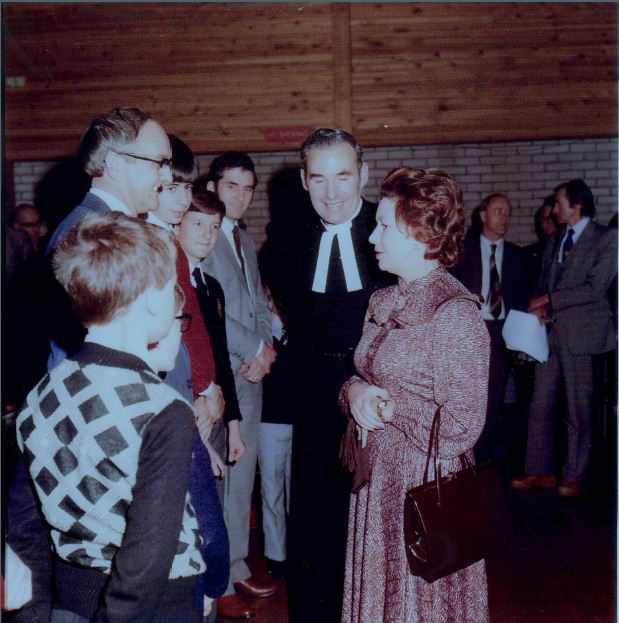
Willenhall between the years 1980 - 1989
- 1980: Extension added to the Willenhall Social Club, making it the largest club in the city
- 1982: Jobless teenagers converted a patch of waste land behind Hagard Youth Centre into a garden
- 1982: Princess Margaret visited Willenhall Social Club, the hagard Community Centre and attended the 25th anniversary service of St John the Divine church
- 1984: Ivy Walk was renamed Tarquin Close
- 1989: Eastern bypass opened by the Minister of Transport

Willenhall between the years 1970 - 1979
- 1970: Willenhall Branch Library opened new premises in the Willenhall Precinct
- 1974: The Hagard Youth Centre opened at Willenhall
- 1974: Three classrooms of Willenhall Wood Junior school were gutted by fire. Two boys aged 8 and 9 admitted arson, but were too young to bring to court

Willenhall between the years 1960 - 1969
- 1960: A footbridge was added to the railway bridge on St James Lane and Willenhall Lane
- 1960: The White Bear pub on St James Lane opened
- 1960: Willenhall Wood Housing estate won a Civic Trust award for high standards of architecture
- 1964: A new Youth Centre was built on Remembrance Road
- 1965: Willenhall becomes a separate ecclesiastical parish when Whitley broke away from the parish of Willenhall
- 1966: The Glade pub opened in Middle Ride
- 1968: The hall and dining room of Willenhall Wood Junior & Infants school, destroyed by fire
- 1969: Crest Hotels Ltd, purchased the Chace Hotel. After alterations it opened as the Coventry Crest Hotel

Willenhall between the years 1950 - 1959
- 1950: One of the WW2 gun site huts from Tile Hill was erected as an extra classroom at Willenhall
- 1950: Willenhall Social Club founded, but without any premises
- 1951: The War Office used Willenhall House on the corner of St James Lane and London Road as a Rescue Training Centre
- 1953: The Chace Junior & Infants school opened on the new Chace estate
- 1955: Work started on the Stonehouse estate, between Stonebridge Highway, London Road at Toll Bar End
- 1956: Foundation stone laid at the St Johns the Divine church Willenhall, designed by Sir Basil Spence
- 1956: Coventry Council took over the Chace Guildhouse from the War Ministry
- 1956: Willenhall Social Club opened
- 1957: St John the Divine Church consecrated
- 1957: Severe poliomyelitis epidemic in Coventry and children warned not to paddle or bathe in the River Sowe at Willenhall
- 1957: Building of Willenhall Wood Estate started
- 1957: Willenhall Branch Library opened in Willenhall Precinct
- 1958: Extensions were added to the Willenhall Social Club
- 1959: The Winnall pub opened in Remembrance Road
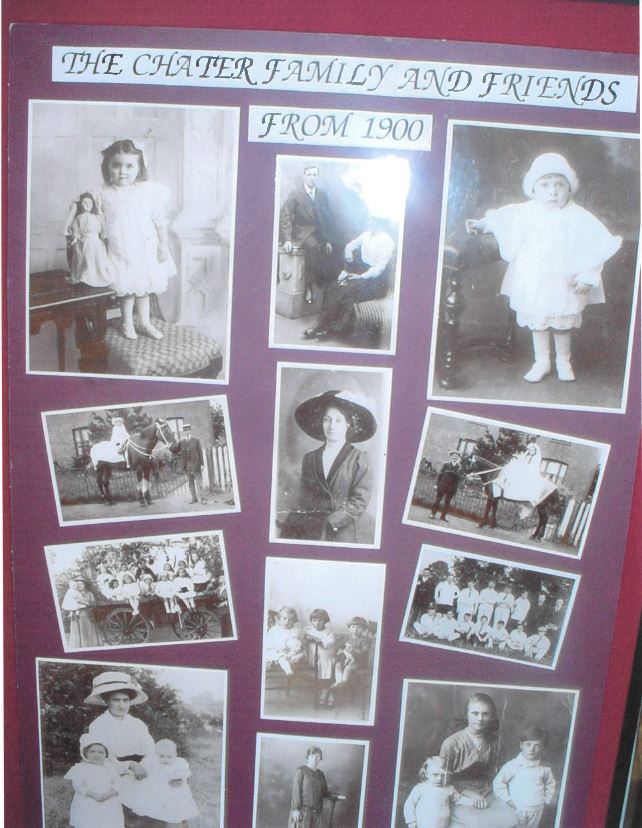
Willenhall between the years 1900 - 1949
- 1901: The population of Willenhall was 111 inhabitants
- 1911: The population of Willenhall was 131 inhabitants
- 1920: A temporary church opened in Willenhall
- 1921: The population of Willenhall was 129 inhabitants
- 1927: Electricity was supplied to Willenhall for the first time
- 1930: Willenhall bridge over the River Sowe was widened
- 1930: The Chace Hotel was opened, after alterations to the original house
- 1932: Coventry extended its boundaries to include Willenhall [456 acres]
- 1935: The Chace building estate, opposite the Chace Hotel, was started
- 1935: St James Mission Church (The Tin Tabernacle) burned down, so services took place at Whitley Abbey Chapel
- 1938: King George VI passed through Willenhall on route to the Rootes factory at Ryton
- 1940: Repairs carried out on St James C of E School, St James Lane
- 1942: New classrooms were added to the school
- 1942: The Ministry of Works built the Chace Hostel for munitions workers on farmland off Chace Avenue
- 1943: Whitley & Willenhall Social Welfare Club inaugurated
- 1945: Total number of voting persons in the Chace Hostel: 826
- 1945: VE Day celebrations held in Dell Close and on St James Lane
- 1947: Total number of Voting persons in the Chace Hostel: 1,100
Willenhall between the years 1000 - 1899
- Year 1000: Roman-British settlement in the area of Willenhall Woods. This was uncovered during the building of the A46 by-pass.
- 1183: Charter of Gerard de Pucella bishop of Coventry to the monks of the Priory of Coventry, taking them under his protection and confirming to them the land on which their church was founded, together with the chapels pertaining to the same. The Chapel of St James at Willenhall was one of these chapels. This is the first written record which mentions the name of Willenhall.
- 1539: Land at Willenhall belonging to Coventry Priory was granted to Sir Richard Lee at the Reformation, who sold it to Thomas Douvia
- 1558: John Hales purchased the Willenhall estate from Thomas Douvia
- 1572: Willenhall Estate passed on to John Hales’ nephew, also named John Hales, after his uncle’s death.
- 1600: During the century the village had its own constable and overseer. The constable’s office was filled annually from within the village
- 1607: John Hales died and the estate passed to his son, also named John Hales
- 1631: John Hales died, Willenhall estate passed to his son Christopher
- 1658: Christopher Hales died, Willenhall estate passed to his son John Hales
- 1677: Sir John Hale died, Willenhall estate passed on to his son Sir Christopher, 2nd Baronet.
- 1687: The date of the original Stone House Farm buildings on the south boundary of Willenhall
- 1690: King William III meet at Willenhall bridge by the Coventry City Sheriffs to escort him into the City
- 1715: Sir Christopher Hales leased the Willenhall estate to Banjamin Wodnah
- 1718: Duke of Montague purchased Willenhall estate from Sir Edward Hales
- 1724: The modern course of London Road was laid out by the Turnpike Company
- 1730: There was a total of fifteen houses in the village of Willenhall
- 1761: A man was found dead in the Crown Inn at Willenhall
- 1790: John Plover of Willenhall, died aged 108, lived for many years on bread boiled in water, and bitters composed of herbs from his own garden, diluted with gin and rum
- 1792: Manor of Willenhall with 30 messuages, 40 gardens, 1,000 acres of land, 500 acres of meadow, 500 acres of pasture, 50 acres of wood, 300 acres of furze and heath, 200 acres of moor
- 1801: The population of Willenhall was 126 inhabitants
- 1805: The bridge over the River Sowe on London Road was repaired
- 1811: Population of Willenhall was 84 inhabitants
- 1814: James Wyatt of Willenhall House died
- 1821: Population of Willenhall was 100 inhabitants
- 1825: Willenhall Tollbar was up for rent
- 1826: First survey done to see where the railway would run, missing Coventry by two miles
- 1826: Mantraps and spring guns were placed in Willenhall woods to catch poachers
- 1831: Population of Willenhall was 120 inhabitants
- 1831: George Stephenson's recommended that the railway should come to Coventry
- 1836: Improvements made to the London Road and the gradient of the hill between Willenhall Bridge and Finford Bridge
- 1837: The railway line from London to Coventry was constructed, cutting through Willenhall and Stoke Aldermoor. 140 oak trees from Middle Fall West in Willenhall Wood were sold by auction.
- 1838: The London to Birmingham Railway opened, cutting the estate in two.
- 1841: The population of Willenhall was 114 inhabitants.
- 1851: The population of Willenhall was 107 inhabitants.
- 1861: The population of Willenhall was 109 inhabitants.
- 1871: The population of Willenhall was 103 inhabitants.
- 1880: Willenhall estate was purchased by the 3rd Earl of Craven of Coombe.
- 1881: The population of Willenhall was 121 inhabitants.
- 1882: The Earl of Craven donated land and money for a school in Willenhall
- 1883: On the death of the 3rd Earl of Craven, the Willenhall estate has passed to his 14 year old son, William George Robert Craven
- 1885: Willenhall Junior & Infants Church of England School was opened in St James Lane. The school also functioned as a church on Sundays
- 1891: The population of Willenhall was 105 inhabitants.
- 1897: Dr C.W. Iliffe, built a manor house for himself at Willenhall, which he named 'The Chace'